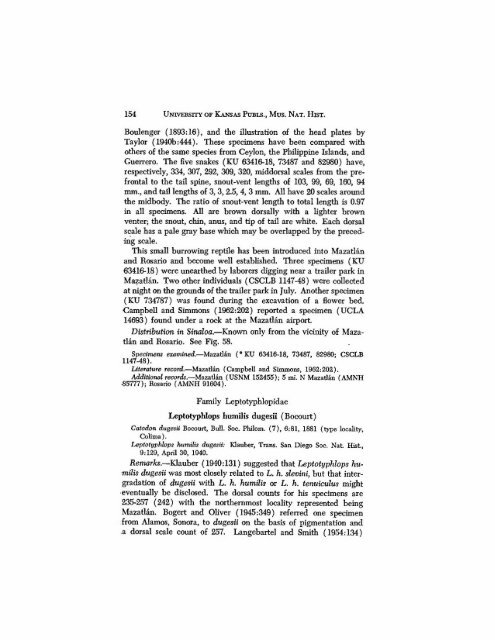The Amphibians and Reptiles of Sinaloa, Mexico - Smithsonian ...
The Amphibians and Reptiles of Sinaloa, Mexico - Smithsonian ...
The Amphibians and Reptiles of Sinaloa, Mexico - Smithsonian ...
Create successful ePaper yourself
Turn your PDF publications into a flip-book with our unique Google optimized e-Paper software.
154 UNIVERSITY OF KANSAS PUBLS., MUS. NAT. HIST.<br />
Boulenger (1893:16), <strong>and</strong> the illustration <strong>of</strong> the head plates by<br />
Taylor (1940b:444). <strong>The</strong>se specimens have been compared with<br />
others <strong>of</strong> the same species from Ceylon, the Philippine Isl<strong>and</strong>s, <strong>and</strong><br />
Guerrero. <strong>The</strong> five snakes (KU 63416-18, 73487 <strong>and</strong> 82980) have,<br />
respectively, 334, 307, 292, 309, 320, middorsal scales from the prefrontal<br />
to the tail spine, snout-vent lengths <strong>of</strong> 103, 99, 69, 160, 94<br />
mm., <strong>and</strong> tail lengths <strong>of</strong> 3, 3, 2.5, 4, 3 mm. All have 20 scales around<br />
the midbody. <strong>The</strong> ratio <strong>of</strong> snout-vent length to total length is 0.97<br />
in all specimens. All are brown dorsally with a lighter brown<br />
venter; the snout, chin, anus, <strong>and</strong> tip <strong>of</strong> tail are white. Each dorsal<br />
scale has a pale gray base which may be overlapped by the preceding<br />
scale.<br />
This small burrowing reptile has been introduced into Mazatlan<br />
<strong>and</strong> Rosario <strong>and</strong> become well established. Three specimens (KU<br />
63416-18) were unearthed by laborers digging near a trailer park in<br />
Mazadan. Two other individuals (CSCLB 1147-48) were collected<br />
at night on the grounds <strong>of</strong> the trailer park in July. Another specimen<br />
(KU 734787) was found during the excavation <strong>of</strong> a flower bed.<br />
Campbell <strong>and</strong> Simmons (1962:202) reported a specimen (UCLA<br />
14693) found under a rock at the Mazatlan airport.<br />
Distribution in <strong>Sinaloa</strong>.—Known only from the vicinity <strong>of</strong> Mazatlan<br />
<strong>and</strong> Rosario. See Fig. 58.<br />
Specimens examined.—Mazatlan (• KU 63416-18, 73487, 82980; CSCLB<br />
1147-48).<br />
Literature record.—Mazatlin (Campbell <strong>and</strong> Simmons, 1962:202).<br />
Additional records.—Mazatlan (USNM 152455); 5 mi. N Mazatlan (AMNH<br />
-85777); Rosario {AMNH 91604).<br />
Family Leptotyphlopidae<br />
Leptotyphlops humilis dugesii (Bocourt)<br />
Catodon dugesii Bocourt, Bull. Soc, Philom. (7), 6:81, 1881 {type locality,<br />
Colima).<br />
Leptotyphlops humilis dugesii: Klauber, Trans. San Diego Soc. Nat Hist.,<br />
9:129, April 30, 1940.<br />
Remarks.—Klauber (1940:131) suggested that Leptotyphlops humMs<br />
dugesii was most closely related to L, h. slevini, but that intergradation<br />
<strong>of</strong> dugesii with L. h. humUis or L. h. tenuiculus might<br />
eventually be disclosed. <strong>The</strong> dorsal counts for his specimens are<br />
235-257 (242) with the northernmost locality represented being<br />
Mazadan. Bogert <strong>and</strong> Oliver (1945:349) referred one specimen<br />
from Alamos, Sonora, to dugesii on the basis <strong>of</strong> pigmentation <strong>and</strong><br />
a dorsal scale count <strong>of</strong> 257. Langebartel <strong>and</strong> Smith (1954:134)
















